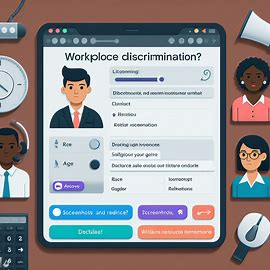Workplace discrimination and harassment are pervasive and persistent problems that affect millions of workers around the world..According to a report by the International Labour Organization (ILO), 16% of women and 10% of men have experienced some form of discrimination at work, and 35% of women and 25% of men have experienced some form of harassment at work. Workplace discrimination and harassment can have negative impacts on the physical and mental health, productivity, and well-being of the victims, as well as the organizational culture and reputation of the employers.
One of the main challenges in addressing workplace discrimination and harassment is the lack of reporting and prevention mechanisms. Many victims of discrimination and harassment do not report their experiences due to fear of retaliation, stigma, or lack of trust in the existing systems. Moreover, many employers do not have effective policies and procedures to prevent and respond to discrimination and harassment cases, or to create a safe and respectful work environment.
This is where chatbots can play a vital role in combating workplace discrimination and harassment. Chatbots are software applications that use natural language processing and artificial intelligence to interact with human users through text or voice. They can provide various services, such as information, guidance, support, or entertainment, depending on the purpose and design of the chatbot.
Providing anonymous and confidential reporting channels: Chatbots can offer a safe and convenient way for victims of discrimination and harassment to report their incidents without revealing their identity or facing any backlash. The chatbots can collect the relevant information, such as the type, frequency, and severity of the discrimination or harassment, the identity of the perpetrator, and the impact on the victim, and forward it to the appropriate authorities or agencies for further action.
The chatbots can also provide the victims with feedback and follow-up on their cases, and ensure that their privacy and confidentiality are protected. For example, Spot is a chatbot that uses evidence-based cognitive interviewing techniques to elicit detail without leading or inserting bias, and generates a time-stamped report that can be sent, anonymously or not, to the employer.
Offering emotional and psychological support: Chatbots can also provide emotional and psychological support to the victims of discrimination and harassment, by listening to their stories, validating their feelings, and offering empathy and compassion. The chatbots can also suggest coping strategies, such as relaxation techniques, positive affirmations, or self-care tips, to help the victims deal with the stress and trauma caused by the discrimination or harassment.
The chatbots can also refer the victims to other sources of help, such as counselors, therapists, or helplines, if they need more professional assistance. For example, Wysa is a chatbot that uses cognitive behavioral therapy and mindfulness techniques to help users cope with various mental health issues, including stress, anxiety, and depression.
Educating and raising awareness: Chatbots can also be used to educate and raise awareness about workplace discrimination and harassment, by providing information, facts, and statistics on the issue, and explaining the rights and responsibilities of the workers and the employers. The chatbots can also dispel myths and stereotypes about discrimination and harassment, and promote a culture of respect, diversity, and inclusion in the workplace.
The chatbots can also engage the users in interactive quizzes, games, or scenarios, to test their knowledge and skills on how to prevent and respond to discrimination and harassment situations. For example, Ally is a chatbot that uses gamification and storytelling to educate users about sexual harassment and bystander intervention.
Chatbots are a solution for workplace discrimination and harassment, as they can provide anonymous and confidential reporting channels, emotional and psychological support, and education and awareness to the victims and the stakeholders. However, chatbots are not a substitute for human intervention, and they have their own limitations and challenges, such as ethical, legal, and technical issues. Therefore, chatbots should be used as a complement to other existing measures, such as policies, training, and counseling, to effectively address workplace discrimination and harassment and create a safe and healthy work environment for everyone.
Workplace discrimination and harassment are serious problems that affect many workers, but they are often underreported and unaddressed. Chatbots can help combat workplace discrimination and harassment by providing a safe and convenient way for victims to report their incidents, receive emotional and psychological support, and learn more about the issue. However, chatbots are not a replacement for human intervention, and they need to be used with caution and care, and with proper safeguards and checks.


Hey there! This post couldn’t be written any better! Reading through this post reminds me of my previous room mate!
He always kept chatting about this. I will forward this write-up to him.
Pretty sure he will have a good read. Thanks for sharing!
my blog: vpn coupon code 2024
I was suggested this web site by my cousin. I’m not sure whether this post is written by him as nobody else know
such detailed about my problem. You are amazing!
Thanks!
Stop by my webpage :: vpn special code
I read this paragraph fully concerning the resemblance of hottest and previous technologies, it’s remarkable article.
Feel free to surf to my web site … facebook vs eharmony to find love online
Thanks for another fantastic post. Where else could anybody get that kind of information in such a perfect way of writing? I’ve a presentation next week, and I am on the look for such info.
You really make it seem so easy with your presentation but I
find this topic to be actually something that I think I would never understand.
It seems too complicated and extremely broad for me. I’m looking forward for your next post, I
will try to get the hang of it!
Feel free to visit my webpage :: nordvpn special coupon code 2024